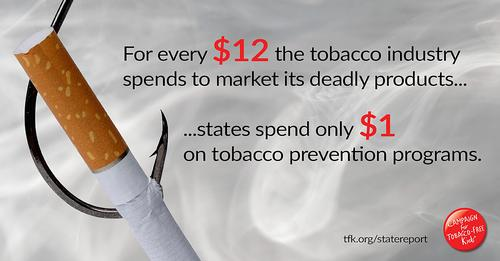
A State-by-State Look at the
1998 Tobacco Settlement 24 Years Later
Despite receiving nearly $27 billion from the tobacco settlement and tobacco taxes this year, the states continue to shortchange tobacco prevention and cessation programs proven to save lives and money. As tobacco use remains the number one cause of preventable death in the United States and youth e-cigarette use remains at high levels, such programs are as critical as ever.
Since the states settled their lawsuits against the major tobacco companies in 1998, our annual reports have assessed whether the states are keeping their promise to use a significant portion of their settlement funds – estimated at $246 billion over the first 25 years – to attack the enormous public health problems caused by tobacco use in the United States.
Despite receiving huge sums from the settlement and collecting billions more in tobacco taxes, the states continue to underfund programs designed to prevent kids from using tobacco products and help tobacco users quit.
In the current budget year, Fiscal Year 2023, the states will collect $26.7 billion from the settlement and taxes. But they will spend just 2.7% of it – $733.1 million – on tobacco prevention and cessation programs. This total is a $14.5 million increase from last year, but still less than a quarter (22.2%) of the total funding recommended by the Centers for Disease Control and Prevention (CDC).
The overall increase in spending can be attributed primarily to five states – Oregon, Maine, Connecticut, Maryland and Oklahoma.
Other key findings in this report:
- Oregon and Maine are the only states to fund tobacco prevention and cessation programs at or above the CDC-recommended levels.
- Only 9 states (Oregon, Maine, Utah, Oklahoma, Delaware, Alaska, North Dakota, California and Hawaii) provide more than half of the CDC-recommended funding.
- 31 states and DC are providing less than 25% of what the CDC recommends; 17 states provide less than 10%; 11 states provide less than 5%.
- Tobacco companies spend more than $12 to market tobacco products for every $1 the states invest to reduce tobacco use. According to the most recent data from the Federal Trade Commission (for 2020), the major cigarette, e-cigarette and smokeless tobacco companies spend $9.1 billion a year – over $1 million per hour – on marketing.
To continue driving down tobacco use, policymakers at all levels should fully implement proven strategies. In addition to funding tobacco prevention and cessation programs, these strategies include ending the sale of all flavored tobacco products, significant tobacco tax increases, comprehensive smoke-free laws, hard-hitting mass media campaigns, and barrier-free insurance coverage for tobacco cessation treatment.
This report is issued by the Campaign for Tobacco-Free Kids, American Heart Association, American Cancer Society Cancer Action Network, American Lung Association, Americans for Nonsmokers’ Rights and Truth Initiative.